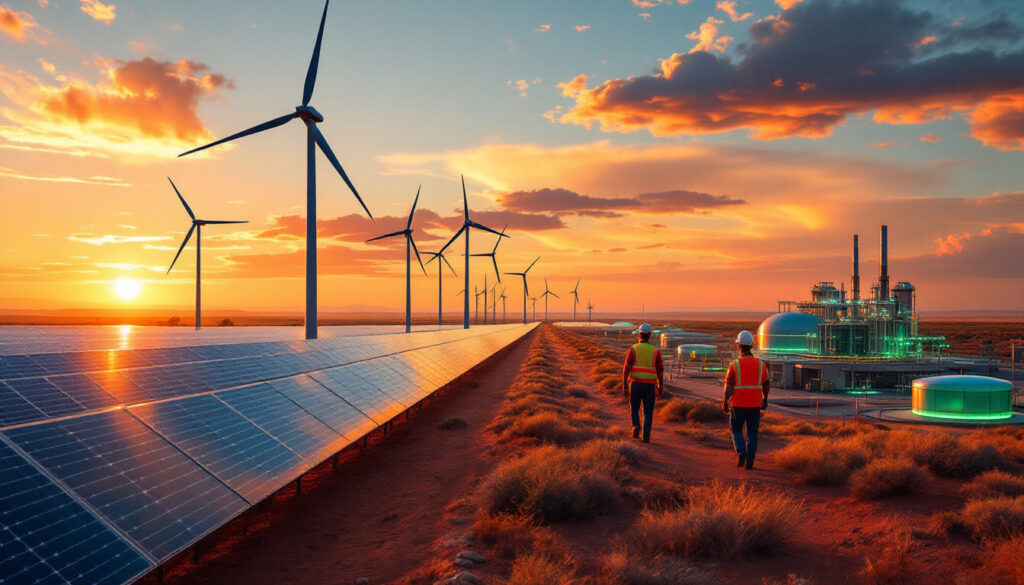Australia's Renewable Energy Future: How Labor's Historic Victory Transforms Global Energy Trade
Australia stands at a pivotal crossroads following Labor's commanding electoral victory in May 2025. This watershed moment could fundamentally reshape the nation's position in global energy markets, transitioning from a traditional fossil fuel exporter to a renewable energy superpower. The implications extend far beyond domestic politics, potentially revolutionizing Australia's economy, global standing, and contribution to climate action.
The Significance of Labor's 2025 Electoral Mandate
Labor's victory on May 6, 2025, delivered one of its strongest parliamentary majorities in Australian history, comparable to John Curtin's transformative win in 1943. This decisive mandate provides the political capital necessary to implement bold energy transition strategies after more than a decade of crippling uncertainty.
"The decisive Albanese victory creates a historic opportunity to change the policy instability that has plagued Australia's energy sector since 2013," noted Professor Ross Garnaut, Chair of the Superpower Institute, during his address at the Energy Users Association of Australia conference days after the election.
This political breakthrough comes at a crucial moment for Australia's energy future. For twelve years, policy reversals and partisan conflicts created market dysfunction, artificially inflated electricity prices, and deterred critical renewable infrastructure investments. Despite renewable energy becoming substantially cheaper than coal-fired power, political barriers maintained fossil fuel subsidies that worked against Australia's economic interests.
With this new mandate, Australia can potentially end the cycle of policy instability that has hindered progress since the dismantling of effective carbon pricing in 2014. Labor's parliamentary strength enables the government to implement consistent, long-term energy policies without the legislative gridlock that characterized previous parliaments.
The "Superpower Trade" Opportunity: Australia's Clean Energy Advantage
Beyond simply replacing fossil fuel exports with renewable energy, Australia now has the opportunity to fundamentally transform its role in global energy markets through what experts call "superpower trade."
According to the Superpower Institute's November 2024 paper "The New Energy Trade," Australia could embed clean energy into essential manufactured materials, creating value-added exports that deliver 6-8 times more revenue than traditional fossil fuel exports. This approach moves Australia up the value chain from raw resource extraction to advanced manufacturing.
Key components of this superpower trade opportunity include:
- Green energy-intensive exports: Manufacturing products like green iron, steel, aluminum, silicon, and ammonia
- Global emissions impact: At full scale, Australia's clean exports could reduce global emissions by 9.6% of 2021 levels by 2060
- Economic diversification: Moving from commodity price vulnerability to stable, value-added manufacturing
Australia possesses natural advantages for renewable energy production that few nations can match:
"Australia has the world's best solar and wind resources, abundant land, established mining expertise, and strong trade relationships with major economies. These advantages create ideal conditions for large-scale renewable energy production," explains Garnaut.
This combination of political stability, vast renewable resources, and existing infrastructure provides Australia with a remarkable competitive advantage in the emerging green economy.
Economic Transformation Through Clean Energy
The scale of potential economic transformation is staggering. According to Professor Garnaut, Australia's electricity system could grow to more than ten times its current size by mid-century, powering not just domestic needs but energy-intensive industries producing goods for export markets.
"Growth in energy-intensive exports will drive productivity restoration after a dozen years of stagnation dating from 2013," Garnaut noted in his post-election analysis. This productivity revival represents a critical opportunity to address Australia's energy exports challenges following more than a decade of underwhelming economic performance.
Key economic benefits include:
- Job creation: New manufacturing industries generating high-skilled employment across engineering, technical and production sectors
- Regional development: Renewable resource zones in regions like Upper Spencer Gulf, Pilbara, and Gladstone revitalizing communities outside major cities
- Value-added exports: Moving beyond raw materials to processed and manufactured goods with higher returns
- Productivity growth: Reversing the productivity decline that has plagued the Australian economy since 2013
The transformation from fossil fuel exporter to clean energy superpower requires substantial investment but promises sustained economic benefits. By leveraging Australia's comparative advantages in renewable resources, the country could establish new industries with decades of growth potential ahead.
Green Hydrogen: Critical Despite Recent Setbacks
Despite several high-profile hydrogen project cancellations in recent years, including Origin Energy abandoning its green hydrogen plans in late 2024, hydrogen technology advances remain essential to Australia's clean energy future.
"Hydrogen is not dead," emphasized Garnaut. "With appropriate policy support, hydrogen-based investments in new export industries are ready to proceed, particularly in regions like South Australia's Upper Spencer Gulf."
Green hydrogen serves multiple critical functions in decarbonization:
- Green iron production: Using hydrogen to reduce iron oxide to iron without coal
- Industrial decarbonization: Providing solutions for hard-to-electrify industrial processes
- Energy storage: Enabling long-duration energy storage to complement batteries
The Whyalla steelworks in South Australia provides a compelling case study. Once facing closure, this industrial facility now has the potential to become a centerpiece of Australia's green hydrogen economy, producing low-carbon steel for domestic and export markets. As Garnaut bluntly stated, Whyalla has "a sustainable future in iron-making based on green hydrogen, or no sustainable future at all."
Current hydrogen production costs remain high at $3-5/kg, but with scaled production and technological improvements, experts project costs falling to around $2/kg by 2030, making green hydrogen economically competitive for industrial applications.
Policy Foundations for the Energy Transformation
While Labor's victory provides the political capital for transformation, specific policy actions are needed to realize Australia's clean energy potential. The past three years saw the beginning of policy development, but a comprehensive framework must now be established.
Key policy requirements include:
- Regulatory certainty: Long-term, stable policies that encourage private investment
- Infrastructure planning: Strategic development of transmission networks, port facilities, and industrial precincts
- Skills development: Educational programs to build workforce capabilities for new industries
- Research support: Continued innovation in renewable technologies and manufacturing processes
The government's recently announced $2 billion Critical Minerals Tax Credit represents a step in the right direction, supporting domestic processing of minerals essential for the clean energy transition. However, much more comprehensive policy action is needed.
Effective policy design must balance multiple objectives:
- Accelerating renewable deployment without compromising reliability
- Managing transition costs while ensuring long-term benefits
- Distributing economic opportunities across regions
- Maintaining international competitiveness during the transition
International Cooperation and Australia's Energy Diplomacy
Australia's success as a renewable energy superpower depends significantly on international climate cooperation. The country's diplomatic efforts will play a crucial role in maintaining and strengthening global commitment to emissions reduction.
"Australia's prosperity depends on global climate action," Garnaut emphasized. This creates an imperative for Australian diplomacy to help preserve and expand favorable conditions for green exports.
China's accelerating decarbonization efforts present particularly important opportunities. Despite recent political tensions, China remains Australia's largest trading partner and is rapidly transitioning its energy system away from coal. This creates natural markets for Australia's future clean energy exports.
The concept of a "green premium" is central to this opportunity. As major economies implement stronger climate policies, products made with clean energy command higher prices. Australia can capture this premium by using green hydrogen to produce zero-carbon versions of products currently made overseas using Australian coal and gas.
Australia's diplomatic approach should mirror successful post-WWII efforts that helped establish international economic cooperation. By actively supporting and strengthening global climate frameworks, Australia protects both its future prosperity and global environmental outcomes.
Regional Transformation Opportunities
Several Australian regions are ideally positioned for immediate renewable energy development and associated manufacturing:
- Upper Spencer Gulf (South Australia): Ready for hydrogen-based iron-making investment
- Gladstone (Queensland): Potential hub for green aluminum and hydrogen production
- Pilbara (Western Australia): Renewable energy to power mineral processing
- Hunter Valley (New South Wales): Transition from coal to renewable energy industries
These regions combine excellent renewable resources with existing industrial infrastructure and workforces. With appropriate support, they could become showcases for Australia's clean energy transformation and provide models for similar transitions globally.
The Upper Spencer Gulf example is particularly promising. The region enjoys world-class solar resources, has existing industrial infrastructure, and could quickly implement hydrogen-based iron production. Success here would demonstrate the viability of renewable-powered industrial processes and attract further investment.
Challenges on the Path to Becoming an Energy Superpower
Despite the promising outlook, significant challenges remain on Australia's path to renewable superpower status. The scale of transformation required is unprecedented and faces multiple obstacles:
- Capital requirements: AEMO estimates suggest Australia needs approximately $1.5 trillion in renewable energy investment by 2050
- Skills gaps: The National Skills Commission projects that at least 15,000 new workers will be needed in clean energy sectors by 2030
- Infrastructure coordination: Aligning transmission, generation, and manufacturing development timelines
- International competition: Other nations with strong renewable resources pursuing similar strategies
- Policy consistency: Maintaining long-term policy stability across electoral cycles
Technical challenges also abound, including scaling green hydrogen production from demonstration to commercial scale, adapting industrial processes to use renewable energy, and integrating variable renewable generation at unprecedented scale.
"Policy consistency across electoral cycles is critical," Garnaut emphasized. Previous renewable energy initiatives have fallen victim to policy reversals following changes of government, creating investor uncertainty and delaying progress.
Australia's Energy Future: Common Questions Answered
How quickly could Australia transition to becoming an energy superpower?
With appropriate policy settings, initial projects could be operational within 3-5 years, with significant scaling over the following decade. By mid-century, Australia's electricity system could be more than ten times its current size, according to the Superpower Institute's modeling.
Will this transition affect energy prices for Australian consumers?
AEMO's 2024 analysis suggests long-term electricity price reductions are possible as renewable penetration increases. However, the transition period may involve some cost increases as new infrastructure is built. Effective policy design can help manage these impacts.
How does this compare to Australia's current fossil fuel exports?
Australia's fossil fuel exports generated approximately $63 billion AUD in 2023. The Superpower Institute projects clean energy exports could eventually generate $378-504 billion annually, representing a 6-8x increase in export revenue.
What happens if global climate commitments weaken?
While strong global climate action strengthens Australia's opportunities, the economics of renewable energy are increasingly favorable regardless of policy settings. Australia's exceptional renewable resources create competitive advantages that will persist even if international climate frameworks evolve.
How will regional communities be affected?
Many regional areas are ideally positioned to benefit from renewable energy development and associated manufacturing. With appropriate planning and community engagement, the transition could revitalize regions currently dependent on fossil fuel industries.
The Road Ahead: From Potential to Reality
Labor's historic victory creates unprecedented potential for Australia's transformation into a renewable energy superpower. The combination of political mandate, natural advantages, and global market trends creates a once-in-a-generation opportunity for industry transformation insights.
However, potential alone is insufficient. Translating this opportunity into reality requires sustained policy commitment, substantial investment, and effective implementation. The decisions made in the coming months and years will determine whether Australia successfully navigates this transition or squanders its advantages.
With thoughtful planning and bold execution, Australia could establish itself as a global leader in clean energy trade, creating prosperity for generations while contributing significantly to global climate solutions. The path forward requires courage, consistency, and commitment – but the potential rewards make the journey worthwhile.
Want to Invest in Australia's Next Renewable Energy Breakthrough?
Discover investment opportunities in Australia's evolving renewable energy sector through Discovery Alert's proprietary Discovery IQ model, which delivers real-time notifications of significant ASX mineral discoveries essential for the clean energy revolution. Explore how historic discoveries generate substantial returns by visiting Discovery Alert's dedicated discoveries page.




